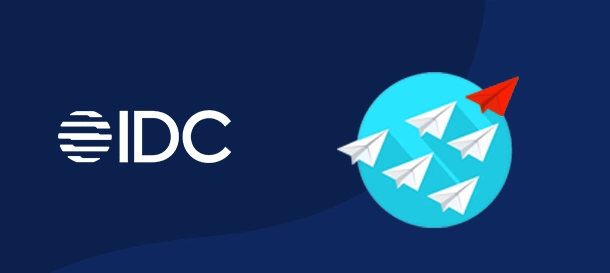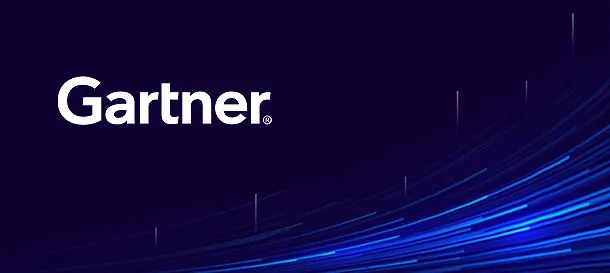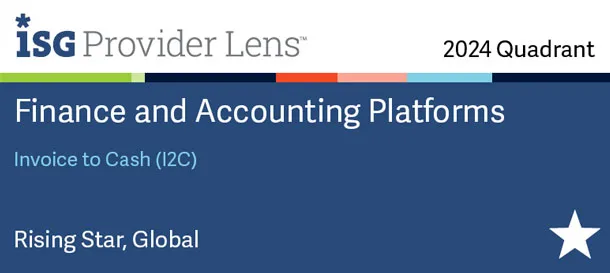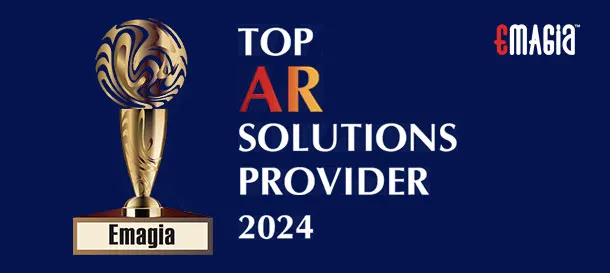Accounts receivable executives are familiar with the term cash application. In this blog, we will look into what is cash application, why is it important, what makes it complex and how to overcome the challenges of cash application automation.
Cash application is the process of matching customer payments and remittance info to corresponding invoices. Unless this is done and the cash is posted in the ERP system, the funds will not be available for use. Cash application is simple in concept but complex in practice.
What is Cash Application?
Cash application refers to the crucial procedure of aligning incoming payments with unpaid invoices and directing them to the appropriate accounts for recording. This crucial practice enables businesses to effectively monitor the flow of cash and capital, ensuring that funds are utilized with utmost efficiency, accuracy, and promptness.
By meticulously executing cash application, organizations can maintain a clear and transparent record of their financial transactions, facilitating optimal financial management and decision-making.
How a Global Medical Supplies Leader Achieved Over 90% Auto-cash Posting. Download Case Study
How is Cash Application Used?
Cash application is an integral part of the broader accounts receivable (AR) process, as it effectively allocates incoming payments to their respective customer accounts and outstanding invoices. Until cash is appropriately assigned, businesses are unable to utilize it for various purposes.
The expedited utilization of cash enables companies to promptly fulfill financial obligations such as paying employee salaries and bills, satisfying purchase orders, exploring additional investment opportunities, and providing dividends to investors. In the digital age, cash application becomes significantly more prominent due to the multitude of payment methods available to customers.
This digital landscape introduces fresh complexities and obstacles for organizations to navigate, demanding innovative strategies and robust systems to effectively manage and reconcile incoming payments. By proactively addressing these challenges, businesses can ensure accurate cash application, minimize discrepancies, and maintain strong customer relationships.
What are the Steps in the Cash Application Process?
1. Receiving Payment and Remittance
Upon receiving a customer’s payment, you typically receive a remittance advice indicating the specific invoice(s) the payment is intended for. For payments made by check, the remittance information may be included in the memo line or an accompanying document attached to the check.
Electronic payments, on the other hand, are more complex. With methods such as ACH, EFT, wire transfers, and virtual cards, the remittance advice may arrive separately in various formats. It is important to note that buyers are not obligated to provide remittance advice, although it is considered a courteous practice. Therefore, there is a possibility of receiving a payment without any associated remittance information.
Modernizing Cash Application with the 3As: Automation, Analytics, and AI. Download Ebook Now
2. Matching the Payment with the Right Invoice
Once a payment is received from a customer, you will compare it with your accounting system to ensure that it is correctly linked to the corresponding invoice. Even when a payment is accompanied by a remittance, the process of matching the payment to the correct invoice can still become intricate.
A single payment can encompass multiple invoices, sometimes exceeding 40 to 50 invoices. Alternatively, you can encounter a situation where the payment does not precisely match the invoice amount. This occurs when a customer has made a partial payment due to a discount or an issue with their order. In such a case, additional investigation by your accounts receivable team is necessary.
What are the Elements of Cash Application?
There are three elements of cash application: Invoice, Payment, and Remittance Advice.
Invoice: The invoice is the document sent to the customer detailing product or service provided and requesting payment per terms and has a corresponding entry in the AR ledger. Invoice document records the money earned by and owed to the company through the sale of products or services on credit.
Payment: Payment is the transfer of funds from the buyer to the supplier. There are many payment methods in business-to-business (B2B) transactions, including paper checks, ACH, wire transfer, credit card, virtual card, and a host of digital payment methods.
Remittance Advice: Remittance advice is the data describing what the payment is being made for. Also known as remittance information or simply remittance, remittance advice is sent along with the payment and includes the invoice number. While the remittance advice is sent with the payment for digital payments, in other modes of payment, this information is sent separately from the actual payment transaction. Customers might send the remittance info in several ways and various formats. These formats could include email, PDF, image file, phone call or web portal.
What’s Wrong with Typical (read: manual) Cash Application Processes
1. Time-consuming
When manually performing cash applications, it becomes necessary to allocate personnel to meticulously analyze a nd input remittance data, especially in cases where the information is either missing or difficult to decipher. To mitigate such challenges, numerous businesses opt for receiving payments via checks, as these often come with an accompanying remittance advice.
2. More Prone to Errors
Despite having meticulous staff, errors are bound to occur when manually inputting data. If a customer notices recurring errors, it can potentially jeopardize the relationship between the parties involved.
3. Slow Down Cash Flow
A manual cash application process increases the time between a sale and the recording of a payment, resulting in higher days of sales outstanding. Delays in cash application also hinder the ability to obtain an accurate and current overview of outstanding receivables.
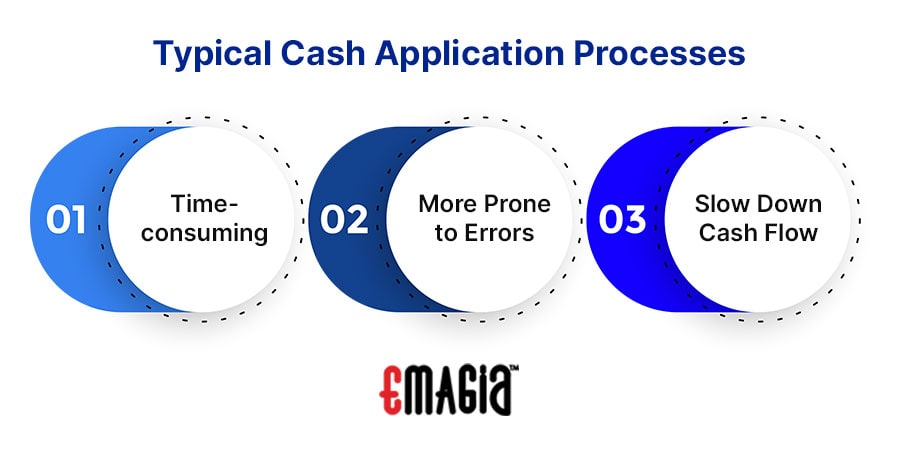
This undermines the ability to distinguish between genuinely delinquent accounts and those awaiting payment recognition. Consequently, cash flow is impeded as funds remain tied up on the balance sheet, limiting the ability to be proactive in collections efforts.
Touchless Cash Posting Made Easy for Global Businesses. Dowload Your Guide
Understanding the Objectives of the Cash Application Process
The cash application process has three purposes:
- Speed: The primary goal is to expedite cash application to minimize days of sales outstanding (DSO) and enable the company to utilize the funds as early as possible.
- Accuracy:Analysts must prioritize cash application accuracy. Errors in cash application can result in dissatisfied clients and disrupt the tracking of cash flow and working capital.
- Standardization: Standardization poses a challenge for global enterprises, as different payment methods and cash remittance file formats across various regions make it difficult to consistently apply cash throughout the organization.
Why is Cash Application Important?
The key elements of cash application are the invoice, the payment, and the remittance advice. Most of the B2B transactions are made on credit. In a typical B2B sales process, the supplier delivers goods or services, expecting payment at a later date. The supplier sets a credit limit for the buyer. When a buyer makes use of the entire line of credit, they can’t make further purchases unless the past purchase payments are paid off. If the supplier’s cash application process is slow, it delays the credit replenishment for the buyer.
This, in turn, impacts the revenue generation for the supplier. Hence whenever a supplier receives a payment, it’s important to “apply cash” to use it back in the business. It’s only when the cash is applied and posted against the corresponding invoice, the money received will be available for use.
An efficient cash application process is vital because companies want to minimize the order-to-cash cycle. Fast cash application lowers past due AR and increase the accuracy of a customer’s account. Efficient cash application is also important to customer experience. For example, with a poor or slow process, the company’s collection specialists may call customers that have already paid. Besides being a waste of time, it reflects poorly on the company and impacts customer relations.
What Makes Cash Application Complex?
Cash Application process includes bringing invoices, receipts and remittances coming from multiple sources such as emails, EDI, bank files, lockbox files etc., in multiple formats, in multiple languages and in multiple currencies. Key challenges associated with cash application process include:
- Data capture from emails, documents, bank files and vendor portals which is very cumbersome
- Matching invoices to receipts is often complex and time-consuming involving several rules
- Data entry and posting into different ERP systems is very tedious and error-prone
Given the number of payment methods and the remittance information coming in different methods and formats—often in unstructured documents such as PDF, Word, or image files—capturing this information poses a huge challenge in cash application.
Further, while matching, some remittance information might be incomplete, complicating the process and requiring contact with the customer to clarify. A thorough matching process requires reference to other customer information (ex: customer purchase orders or internal sales orders along with invoices). In addition, customer history can provide important clues. These all have required human intervention in the crucial effort to match payments to charges correctly, and they make cash application
How to Achieve Digital World Class Cash Application Efficiency using AI. Get eBook
What are the Complexities Related to Cash Application?
1. Lockbox Fees Become Too High of an Expense
Bank lockbox services consolidate all client checks in a centralized location, reducing the time it takes for checks to clear. Dedicated lockbox teams handle each check and input the relevant information into an electronic file shared with the cash application team.
However, lockbox key-in services incur charges based on the number of keystrokes required. Considering the cost of $1-3 per check, the cash application process can become expensive. Apart from the high lockbox key-in fees, this manual intervention consumes significant man-hours to reprocess a check already processed by the lockbox services.
2. Manual Payment-Remittance Linking
When it comes to electronic payments, customers transmit cash remittances through channels such as emails, EDIs, or A/P portals. Cash application teams then face the challenge of manually extracting or downloading this remittance from different sources and in various file formats.
The next step involves mapping these remittances to the corresponding incoming payments. This process is time-consuming and can significantly impact the efficiency of cash application analysts.
3. Invoice Matching and Exception Handling
Cash application analysts are responsible for correlating payments with invoices using the information provided in the remittance such as invoice numbers, purchase orders, or shipment details.
However, complications arise when remittances contain inaccurate or incomplete invoice numbers, making it difficult for analysts to accurately match invoices with payments. In such a situation, payments are applied at an account level rather than at an individual invoice level.
How Cash Application Impacts Business Relationships
Customers often make short payments for various reasons, such as trade promotions, early payment discounts, or disputed goods. When providing the remittance, they typically indicate the reason for the short payment.
Cash application analysts are then tasked with manually identifying these short payments and mapping customer-specific reason codes to the corresponding reason codes within their specific ERP system. Companies utilize multiple ERP systems, including SAP, JD Edwards, Microsoft, or legacy systems, each with its unique configurations.
Analysts also have to handle exceptions or adjust the file as necessary before posting it to the appropriate ERP systems.
How to Achieve Hyper-efficiency in Cash Application?
In a growing enterprise, manual cash application becomes unsustainable. Tools including OCR, auto-cash engines, and robotic process automation (RPA) help relieve companies of repetitive and manual process tasks, but their limitations still require much human intervention. With gaining control on cash becoming more critical than ever, AI-powered cash application can help achieve hyper-efficiency.
Cash application and cash posting can be accelerated using solutions such as Emagia AI-powered Cash Application – a cloud-based solution that integrates seamlessly with leading banks, electronic lockboxes and ERP systems such as SAP, Oracle, NetSuite, JD Edwards and others. This intelligent solution leverages automation, analytics and AI to match invoices to incoming payments and remittances that come in multiple data and document formats in multiple languages and multiple currencies.
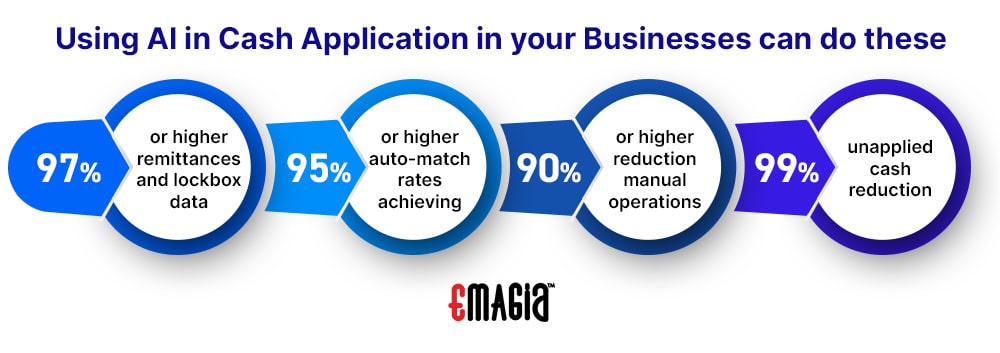
The solution can empower businesses to achieve 90% and above auto-match rates while drastically reducing the time and effort involved with manual cash application processing. It even automates dispute resolution as well, supported by Gia – Emagia’s AI-powered Digital Finance Assistant.
Contact us to know more about how to gain exponential advantage in your AR operations with Emagia Cash Application.
Cash Application – Frequently Asked Questions (FAQs)
The Benefits of Cash Application Automation
1. Less Time Spent Obtaining Remittances from Different Sources
Cash application software offers the convenience of gathering remittances from various sources such as lockboxes, AP portals, emails, and PDFs, eliminating the need for manual collection. These software platforms can extract relevant information such as invoice numbers, dates, and dollar amounts from the remittance data.
In cases where remittance is absent, but previous transactions have been made by the same customer, AI-enabled cash application software can accurately associate the payment with the correct account by leveraging data such as the numbers present at the bottom of a check.
2. Payments Matched with Invoices
Automated cash application eliminates manual intervention by matching a large volume of payments and invoices. Recent advancements in cash application software resulted in impressive match rates exceeding 90%. Where there is a one-to-one match and it is not possible, AI software can determine which invoices are being paid.
By analyzing potential combinations of invoices and considering the customer’s available credits, the software makes informed decisions. In cases where uncertainty remains regarding how to allocate customer payments, software that supports in-platform collaboration offers a convenient solution.
This feature allows users to leave comments directly on invoices, facilitating communication with colleagues or customers without disrupting workflow.
Conclusion:
In conclusion, cash application is a critical process in financial operations that involves matching payments with invoices accurately and efficiently. Manual cash application methods can be time-consuming, prone tot errors, and hinder the overall cash flow of a business. However, advancements in cash application software and automation have improved the process, allowing for faster and more accurate matching of payments and invoices.
Automated cash application software can aggregate remittances from various sources, extract relevant data, and normalize irregularly formatted information. With AI capabilities, it can even make educated guesses when a one-to-one match is not possible, considering available credits and potential invoice combinations.
By adopting automated cash application solutions, businesses can streamline their cash management processes, reduce errors, enhance customer satisfaction, and ultimately optimize their overall financial operations.
How Emagia’s AI-Powered Cash Application Transforms Accounts Receivable
Emagia’s AI-driven cash application solution revolutionizes accounts receivable by leveraging artificial intelligence, machine learning, and advanced automation. It eliminates manual intervention, reduces errors, and accelerates the entire cash application cycle.
Key AI-Driven Features of Emagia’s Cash Application Solution
- AI-Powered Payment Matching
- Automatically matches incoming payments with open invoices using machine learning algorithms.
- Improves accuracy by handling complex scenarios, such as partial payments and deductions.
- Smart Remittance Capture with AI
- Uses Natural Language Processing (NLP) to extract remittance details from emails, PDFs, bank statements, and customer portals.
- AI ensures data accuracy, even when remittance formats vary.
- Predictive Analytics for Cash Flow Management
- AI analyzes historical payment patterns to predict future cash flows.
- Provides data-driven insights to optimize working capital and reduce revenue leakage.
- Automated Exception Handling with AI
- Identifies mismatches and exceptions, providing suggested resolutions based on past data.
- Reduces time spent on dispute resolution, improving efficiency.
- Seamless ERP Integration with AI-Enabled Data Mapping
- AI automates data transformation for seamless integration with ERP and accounting systems.
- Eliminates the need for manual data entry, reducing errors and processing time.
- Real-Time Cash Visibility AI-Driven Insights
- Provides real-time dashboards with AI-driven recommendations for better decision-making.
- Enhances transparency and control over accounts receivable operations.
- AI-Powered Fraud Detection Compliance Monitoring
- Detects anomalies in transactions to prevent fraud and ensure compliance.
- Uses AI algorithms to flag suspicious activities for review.
By implementing Emagia’s AI-powered cash application solution, businesses can automate over 95% of their cash application process, reduce Days Sales Outstanding (DSO), and gain full control over their cash flow.
FAQs
Is it Safe to Use Cash Applications?
Yes
Are there Benefits to using Cash Applications?
When a company earns its funds, it can utilize that money to fund payroll.
What is the Rate of a Cash Application?
The rate assesses the ability of a business to match the payments with invoices.
What are Cash Application Factors?
Payment, remittance advice, and invoice.
What Does the Cash Application Manager Do?
It automates the cash application for payments in the SAP, Oracle, NetSuite, JD Edwards, PeopleSoft, and others.
What is cash application in accounts receivable?
Cash application is the process of matching incoming customer payments to their corresponding invoices in the accounts receivable system. It ensures accurate financial records and proper cash flow management.
Why is cash application important?
Cash application is crucial for maintaining accurate accounts, reducing payment discrepancies, improving customer relationships, and ensuring efficient cash flow management.
How does automation improve the cash application process?
Automation eliminates manual data entry, enhances accuracy, speeds up processing times, reduces operational costs, and provides real-time insights into cash flow.
What are the common challenges in manual cash application?
Common challenges include slow processing, human errors, difficulty handling remittance data from multiple sources, delayed cash visibility, and resource-intensive exception management.
How does AI-powered cash application work?
AI-powered cash application uses machine learning to automatically match payments with invoices, extract remittance details, handle exceptions, and integrate with ERP systems for seamless financial management.
What are the key features of a good cash application solution?
A good cash application solution should offer automated payment matching, multi-channel remittance processing, AI-powered exception management, ERP integration, and real-time reporting.
How can Emagia’s cash application solution help businesses?
Emagia’s AI-driven cash application automates over 95% of the process, reducing manual intervention, improving accuracy, handling complex remittance data, and providing real-time cash flow insights.
What industries benefit from cash application automation?
Industries like manufacturing, retail, healthcare, financial services, logistics, and B2B enterprises benefit significantly from cash application automation due to high transaction volumes.
How does cash application integrate with ERP systems?
Cash application solutions integrate with ERP systems via APIs, allowing seamless data exchange, automated posting, and real-time visibility into accounts receivable.
What is the future of cash application?
The future of cash application lies in AI-driven automation, predictive analytics, blockchain for secure transactions, and enhanced integrations with cloud-based ERP systems.
Final Thoughts
A well-optimized cash application process is essential for efficient accounts receivable management. Businesses that adopt AI-powered automation, like Emagia’s solution, can experience faster payment processing, reduced errors, improved cash visibility, and enhanced financial operations.
By leveraging modern technology, companies can streamline cash application, minimize revenue leakage, and improve overall operational efficiency. If you’re looking to optimize your cash application process, investing in AI-driven automation is the key to staying competitive in today’s fast-paced financial landscape.








